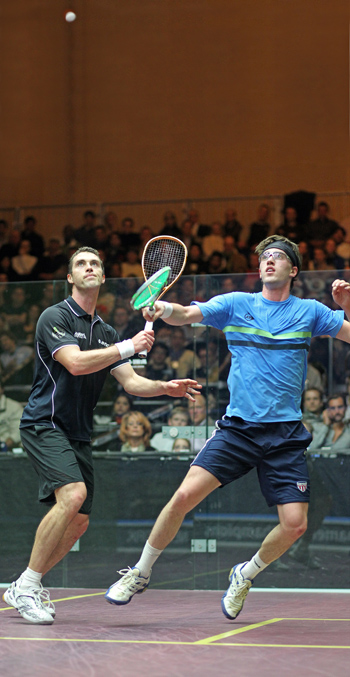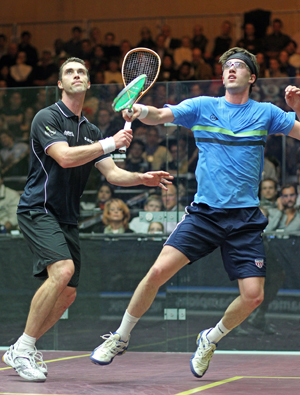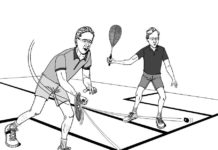By Barry Faguy

HEY REF! I was getting out of trouble in the front left corner with a high lob right over myself. My opponent called ‘Let’ as the ball was fourteen or fifteen feet high—so naturally, I stopped clearing—yet the ref awarded a stroke. That doesn’t seem right?
The concept of ‘timing’ has a great many applications relating to interference—and we’ve already dealt with some of them (e.g., for ‘access’ and ‘backswing’ issues). In this case, we’re talking about what is commonly referred to as ‘crossing the flight’ (referring to the potential for the non-striker to be hit by the ball on the way to the front wall). Indeed, the request for let often is made too early, as it appears in this case. The same often applies with returns at ground level directly back towards the player that hit it—where referees often get suckered into strokes for these because it just “looks like a stroke”—reflexively categorizing it as a ‘bad shot’. Again, because the newest edition of the rules have no guidelines, we have to refer to the previous edition where the referee was instructed to extrapolate the various movements (ball & players) to the point where the ball would have been hit—which is some time later than the call of ‘Let’. We really don’t need the rules to tell us that; it’s just common sense.
HEY REF! I was refereeing a match where the striker made a fake swing at the ball and allowed the ball to continue to the back wall. He then hit it when it came off the back, and the ball struck the opponent while it was going directly to the front wall. I awarded a stroke—but then all hell broke loose. What did I do wrong?
The key thing to remember for such situations is that the rules consider a fake swing (or feint) as an attempt. This means that for situations where the concept of ‘further attempt’ comes into play (meaning either ‘swing interference’ or ‘ball hitting a player’), we need to use exceptions to the main rule. The rules call for a Let if the striker was making a further attempt. It’s interesting to note that if instead, the opponent had been similarly hit, but after the striker had turned, it would be a Stroke to the opponent (done to promote safety). Yes, I know that some of you may wonder why it isn’t a Stroke with a further attempt’ situation as well—since it’s actually easier for the striker to know where the opponent is in those situations. I don’t know.
HEY REF! I got injured by tripping over my opponent and twisting my knee on the way to the ball—and the Referee declared it to be a ‘contributed’ injury, allowing me fifteen minutes to recover. I took a few minutes and it felt OK, so we started up again—but after about two rallies, I realized it was not OK and it was causing me to limp. I asked for more time but was refused—and was told the only thing I could do was to forfeit that game and take the ninety seconds to recover. Was that right?
Yes. The rules make it very clear that it is the injured player’s decision as to whether or not to resume play, but once it has resumed, a commitment has been made. In the future, if you have doubts, take the full time allowed—or at least put the injured area to a good test first. The same applies for bleeding; make darn sure that it has stopped before resuming play—because it’ll cost you a game if the same wound starts bleeding again.





